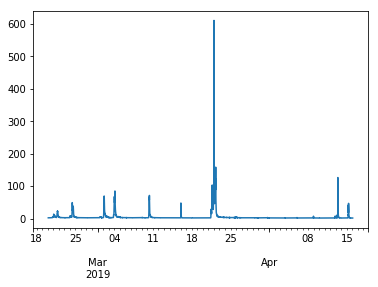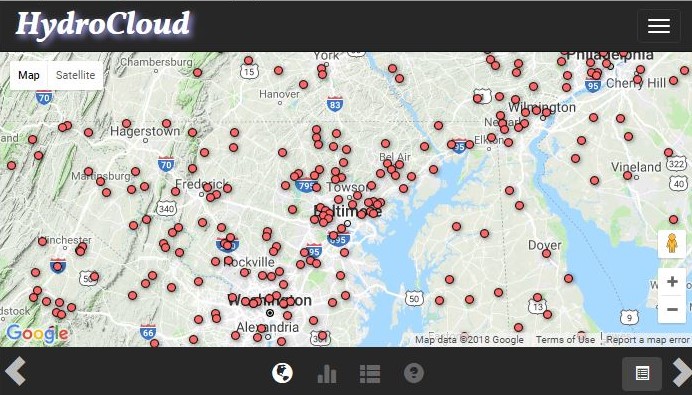A suite of convenience functions for exploring water data in a Jupyter Notebook.
Project description
HydroFunctions





a suite of convenience functions for exploring water data in Python.
Features
Retrieves stream data from the USGS NWIS service
Retrieve data using multiple site numbers, state, county codes, or boundary box
Preserves NWIS metadata, including NoData values
Helpful error messages to help you write valid requests
Extracts data into a Pandas dataframe, json, or dict
Plotting and manipulation through Pandas dataframes
Interactive map for finding stream gage ID numbers
Still in early development! More features to come!
Read the Users Guide for more details.
Basic Usage
First, import hydrofunctions into your project and enable automatic chart display:
>>> import hydrofunctions as hf >>> %matplotlib inline
Create NWIS data object to hold our request and the data we will retrieve. We will request the daily values (‘dv’) for site ‘0158520’ for the past 55 days:
>>> herring = hf.NWIS('01585200', 'dv', period='P55D')
We’ve set up our system, now we submit our request for data and get a response:
>>> herring.get_data() <hydrofunctions.station.NWIS at 0x127506d6ac8>
Create a dataframe from our data, and list the first five items:
>>> herring.df().head()
–a table with our data appears–
datetime
01585200 - Mean Discharge, cubic feet per second
2017-06-01
0.71
2017-06-02
0.64
2017-06-03
0.61
2017-06-04
0.58
2017-06-05
1.95
Plot the data using built-in methods from Pandas and mathplotlib:
>>> herring.df().plot()
–a stream hydrograph appears–

Draw an interactive map in a Jupyter Notebook:

Learn more:
More usage tips
Introduction to Hydrofunctions, a Jupyter Notebook with a quick tutorial.
Easy Installation
The easiest way to install Hydrofunctions is by typing this from your command line:
$ pip install hydrofunctionsHydrofunctions depends upon Pandas and numerous other scientific packages for Python. Anaconda is an easy, safe, open-source method for downloading everything and avoiding conflicts with other versions of Python that might be running on your computer.
Visit the Installation Page in the Users Guide to learn how to install Anaconda, or if you have problems using the Easy Installation method above.
Other Projects You Should See
Hydropy, a Python package that builds upon Pandas for enhanced data selection and plotting of hydrology data.
WellApplication a Python package that provides functions for working with dataloggers and USGS well data.
This package was created with Cookiecutter and the audreyr/cookiecutter-pypackage project template.
MIT License
Copyright (c) 2016, Martin Roberge and contributors
History
0.1.0 (2016-08-11)
Project set up.
0.1.1 (2016-08-11)
Customized project boilerplate.
0.1.2 (2016-08-26)
Set up template for custom exceptions
Added get_nwis function
0.1.3 (2016-09-09)
Check user inputs & raise explanatory exceptions
Extract data from response into a dataframe.
Stations object for managing data.
0.1.4 (2016-09-18)
Added tests & documentation.
0.1.5 (2018-02-22)
Updated to support Python 3.6
Updated docs, added notebooks (mcr jdh)
Added parameterCd to allow requests for different datasets (thanks @jdhughes-usgs!)
Added ability to query sites by state or county (jdh)
Added ability to request lists of sites or counties (jdh)
Improved column names: now includes site id & variable description (for example, ‘07228000 - Mean Discharge, cubic feet per second’)(jdh)
Added descriptive warnings to explain why queries fail (mcr)
0.1.6 (2018-03-07)
Added draw_map function for help selecting sites (mcr)
Added ability to query sites by a bounding box (jdh)
Revised pandas dataframe column names to be the name composed of the provider, site id, parameter, and statistic (for example. USGS:01638500:00060:0001). (jdh)
Added qualifiers for each station as a column in the dataframe. (jdh)
Added ability extract NWIS property data from the response object (for example, siteName). (jdh)
0.1.7 (2018-11-11)
Added a flow duration chart (mcr)
Added the cycleplot chart (mcr)
Added code coverage (mcr)
Improved the build scripts for TravisCI (mcr)
Updated to support Python 3.7
Project details
Release history Release notifications | RSS feed
Download files
Download the file for your platform. If you're not sure which to choose, learn more about installing packages.
Source Distribution
Built Distributions
Hashes for hydrofunctions-0.1.7.1-py2.py3-none-any.whl
| Algorithm | Hash digest | |
|---|---|---|
| SHA256 | 8d05f11b985dd01e5ffbe4042d8bc803593d2e0fc8ca1906973375bcfa80c6b7 |
|
| MD5 | e22a22d54bce9c5226cc9ab1e6911be1 |
|
| BLAKE2b-256 | a34314995311e70b4a6c07bb59406ec888703a9df7f15bcc544aee4eb3a65246 |
Hashes for hydrofunctions-0.1.7-py2.py3-none-any.whl
| Algorithm | Hash digest | |
|---|---|---|
| SHA256 | 8f6636f23b0aa7406e72d29435ec3eb72fb9b14989ac4fa019309ef19b723c8f |
|
| MD5 | 8fdc762178eb546980f6c1ebeba08680 |
|
| BLAKE2b-256 | 8cc599064d0981546ecb78071a8e0fd5114e1023e2945d2a01f88960af839017 |











